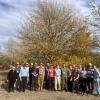Editor's Picks
Plant Focus
Voting for the European Tree of Year 2021 competition is taking place in February and closes on the last day of the month. Fourteen trees have been nominated by each of the countries participating in the event, having won their respective national competitions. Several genera are in the final round, including Quercus, with two candidates.

Representing Slovakia is an oak from Drnava, a village near Rožňava, in the Košice region. The ancient Quercus robur is located in the former premises of famous iron and steel works of Count Andrássy, where components of the famous Széchenyi Chain Bridge in Budapest were produced in the 1840s. This earned the village the nickname of “Kis Pest“ (Little Pest). Today this ancient oak is one of the stops on the educational trail "Treasures of Drnava" that goes through the village, reminding visitors of the village’s mining history. Standing on an old trading route, the oak tree has been one of the essential symbols of the village for many generations: the first mention of the oak in the village chronicles dates to 1670.
Spain’s nominee is a Q. ilex in the northeastern region of Aragon. The name of the village where it stands, Lecina, is itself an old name for holm oak in the Aragonese dialect. The tree is known by another local name for Q. ilex: carrasca. Oaks were of course considered sacred trees in ancient times and that is certainly the case in Aragon, where all kinds of agreements, such as business deals, weddings, land ownership issues or boundaries, are celebrated in the shade of a holm oak. If what was to be agreed upon involved two locations, the largest holm oak located midway between them was chosen. If the matter was of greater relevance, the most famous tree of the region or kingdom was chosen. This legendary tree is included in the coat of arms of Aragon, whose upper left quarter features a holm oak with a red cross above it. According to legend, in the 8th century the Iacetani, an Iberian tribe, had come to the town of Aínsa to reconquer this territory from the Moors. When the Iacetani were losing the battle, a red cross appeared hovering above an oak tree and at that point the fortunes of the battle changed. The Iacetani won the battle and regained Aínsa. The holm oak with its red cross became the symbol of the district of Sobrarbe (the name derives from sobre árbol, "above a tree").

The carrasca at Lecina also has its own legend. It is said that long ago Lecina was surrounded by impenetrable and mysterious forests of holm oaks, home to wolves and bears—and witches. The villagers feared the witches, who they believed caused diseases and sent terrible storms that ravaged the town. However, the holm oaks in the forest were happy, because the local people were so afraid of the witches that they did not dare enter the forest to make firewood. One of the youngest of the holm oaks was not happy about the forest’s bad reputation and she felt sorry for the villagers, so much so that she would not let witches take refuge in her branches.

Due to her attitude, disagreements with the other trees were frequent. The witches, who heard the protests about the young holm oak, decided to go to another forest and, as a gesture of gratitude to the older ones for their moral support, they granted each tree a wish. The most presumptuous wanted their branches and leaves to be made of gold, others wished that their leaves should exude delicious perfumes, and the rest requested that their leaves be turned to crystal. Only the small holm oak wanted to continue just the same as she was.
The witches granted their wishes. On the third day after the witches left the forest, there was a terrible storm. The crystal leaves all fell to the ground and shattered, causing the demise of those trees. Another day, a shepherd could not prevent his flock from rushing to eat the aromatic leaves, and from then on the inhabitants cut down these oaks to feed the leaves to their livestock. Later the golden trees were torn to pieces by thieves. Of all that impenetrable forest, only our small holm oak remained. It has not stopped growing and today is respected and admired by everyone.

The nomination of an Aragonese holm oak this year is also linked to COVID-19. On June 27, 2020, a region-wide memorial ceremony took place, under the slogan "Aragon, those who are missing". As a tribute to the victims of the COVID-19 pandemic, 731 holm oaks were planted, one in each municipality of the autonomous community of Aragon. The ceremony was a tribute to the victims, but also a symbol of gratitude to health workers and nursing homes, to the State security forces and bodies, to essential services, and to all those who have guaranteed the production and availability of food.
In Zaragoza, the capital city of Aragon, the planting ceremony was held in the Plaza de la Ciudadanía. Following a ceremonial drum roll played on seven drums, each representing a root of the holm oak as depicted on the Aragonese coat of arms, the tree was planted in a spot facing the Palace of La Aljafería, seat of the Aragonese Parliament. The son and granddaughter of the first COVID victim planted the seedling and placed a ceramic plaque that reads: “This holm oak symbolizes the memory that takes root and grows within us, and which we all must help grow.”
You can cast your vote for the European Tree of the Year at the website www.treeoftheyear.org . As Oak News & Notes goes to press, the Carrasca de Lecina is in the lead, but an Italian plain tree (Platanus orientalis) is close on its heels. During the last week of voting, votes will be secret and preliminary vote counts will not be available on the webpage. Which tree you vote for is of course a matter of personal choice, but IOS members will be expected to do their duty! The winner will be announced at an Award Ceremony on March 17.















